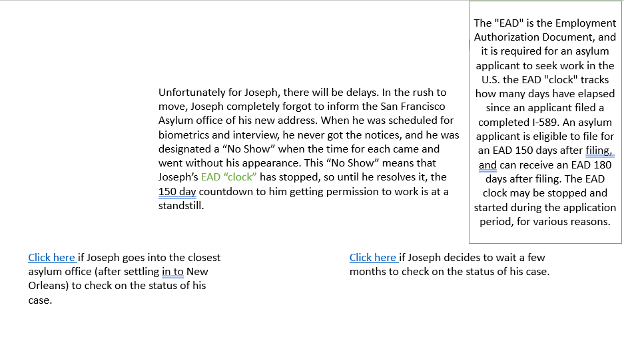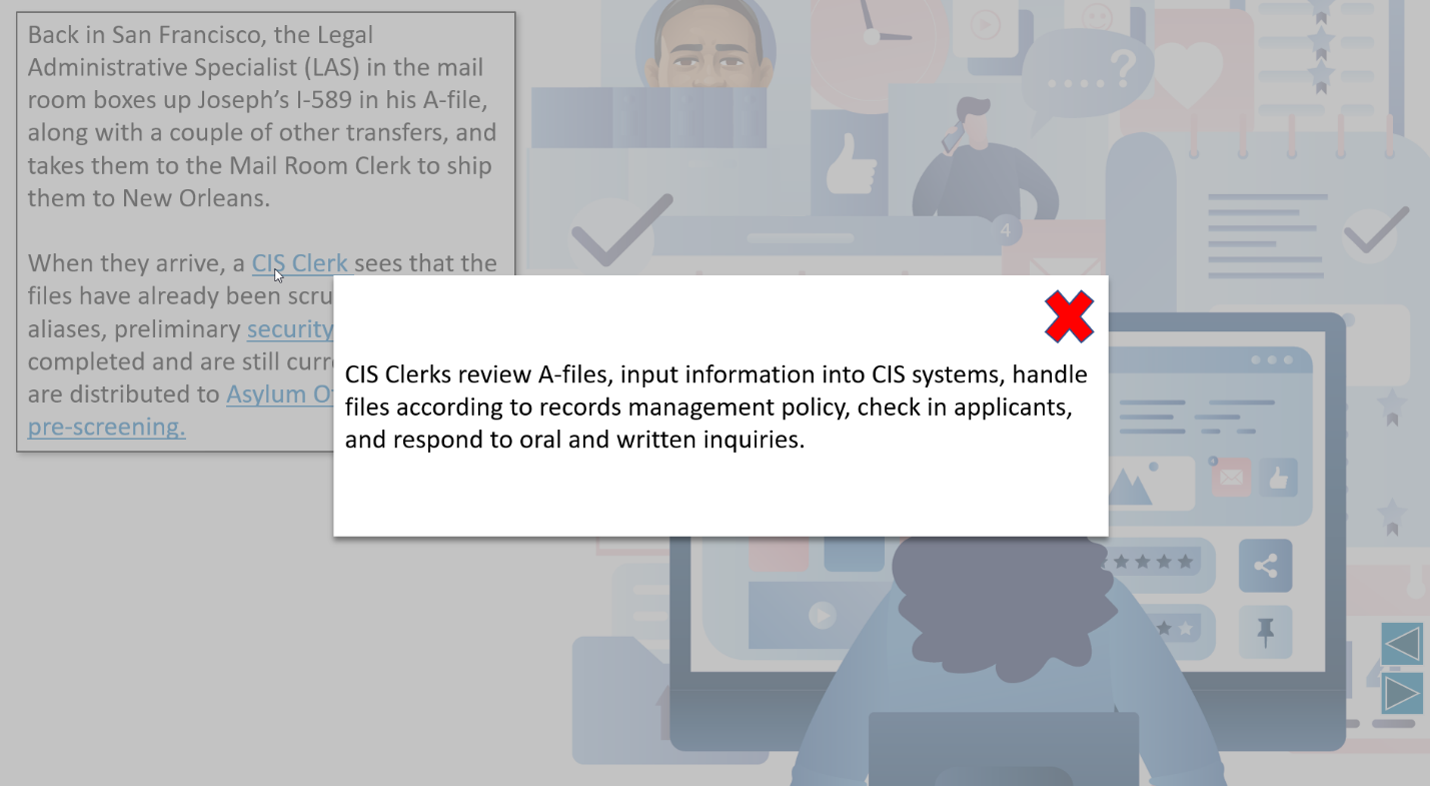Reimagining Federal Employee Onboarding Through Human-Centered Design
Overview
Led an 8-person cross-functional team at a Federal Government Agency to design a comprehensive onboarding experience using participatory design methods. The project aimed to transform how new employees were welcomed and integrated into the organization, replacing a fragmented approach with a cohesive, empathy-driven program that combined virtual cohort learning with localized experiences.
My Role: Project lead, design thinking facilitator, and mentor to team members new to human-centered design methodologies.
Timeline: 1.5 years (2020-2021)
Process and Approach
-
The Federal Agency faced multiple interconnected challenges with their existing onboarding practices:
Resource constraints: Individual offices were overburdened with onboarding responsibilities while already being resource-strapped
Knowledge gaps: New employees lacked a solid foundation of understanding about the organization and asylum processes
Inconsistent experiences: Onboarding quality varied significantly across geographically dispersed offices
Employee retention: The agency struggled with turnover partly due to inadequate initial support
Low morale: New hires often felt overwhelmed and disconnected from the agency's mission and purpose
According to the Society for Human Resource Management (SHRM), effective onboarding programs can improve employee retention by 25%—making strategic onboarding not just a nice-to-have but a critical business need.
The organization needed a more effective way to:
Support new employees during their critical first months
Build consistency across geographically dispersed offices
Help new hires understand the complex asylum application process
Improve retention rates and employee satisfaction
Create a sense of shared purpose across diverse roles
Reduce the burden on individual offices
-
Conducted qualitative research through interviews and focus groups with new and existing employees
Gathered quantitative insights via surveys to identify patterns across offices and roles
Analyzed industry trends and best practices in employee onboarding
Identified key pain points in the current onboarding experience
Key Research Insights
Inconsistent experiences: Vastly different onboarding approaches across offices created silos of knowledge
Organizational friction: Inconsistent onboarding led to frustration when collaborating with colleagues from other parts of the organization
Missing context: New hires lacked understanding of how different organizational components worked together
Unequal foundations: Variable onboarding quality created disparities in career starting points for new employees
-
Facilitated a participatory design sprint with cross-functional team members
Mentored team members in design thinking methodologies while leveraging their diverse organizational knowledge
Activities included:
Persona building: Created representative new hire personas based on research
Journey mapping: Mapped current onboarding experiences across different offices
Problem framing: Articulated specific challenges to address
Ideation: Generated potential solutions through collaborative brainstorming
Complexity and impact mapping: Prioritized solutions based on feasibility and potential impact
Prototyping: Developed low-fidelity prototypes for testing key concepts
-
Developed curriculum framework for a 40-hour onboarding program
Created prototype "onboarding toolkits" for local office customization
Built a low-fidelity interactive storytelling prototype to illustrate the asylum application process and how different job roles interact with the application.
Conducted user interviews with prototypes and collected feedback.
Observed users interacting with prototypes and cataloged common behavior patterns.
The Solution
Hybrid Onboarding Model
The 40-hour curriculum delivered through a combination of:
Virtual cohort-based learning across the organization
Locally delivered, customizable in-person experiences
Self-paced interactive learning modules
Onboarding Toolkits
Developed physical and digital resource packages for local offices
Included standardized materials with consistent branding and messaging
Provided customization options to address local office needs and culture
Created implementation guides for local onboarding coordinators
Program Support Structure
Designed a centralized coordination model with local implementation points
Created role descriptions for program facilitators
Established metrics for program success and continuous improvement
Developed a phased implementation plan to manage resource constraints
Interactive Storytelling Tool
Designed a "choose your own adventure" experience following an asylum application
Innovative implementation:
Initial prototype developed in PowerPoint for accessibility and easy editing by non-technical SMEs
Beta version created in Articulate 360's StoryLine for enhanced interactivity
Continues to be used for training onboarding contractors and IT partners within the innovation division
Incorporated decision points that affected story outcomes
Built empathy for asylum seekers through immersive storytelling
Highlighted interdependencies between different parts of the organization
Enabled new hires to understand process complexity through an engaging format
The storytelling tool serves as the cornerstone of the solution, making abstract processes tangible and helping new employees understand both the applicant experience and the interconnectedness of organizational roles.

Low fidelity prototype

Creating the interactive structure

Final version - showcasing various roles

Interactivity when selecting a key word

Users choose the story’s path and unfold different outcomes
-
Although the program was not ultimately implemented due to resource constraints, the project delivered several valuable outputs:
Comprehensive onboarding blueprint: A fully designed 40-hour curriculum and operational structure ready for implementation
Innovative storytelling tool: A functional prototype of the interactive asylum application journey
Scalable toolkit concept: A replicable model for consistent yet locally adaptable onboarding
Cross-functional collaboration model: Demonstration of how diverse team members can effectively contribute to service design
Research insights: Documented findings about employee experiences that remain valuable for future initiatives
Expected Impact (if implemented):
Reduced turnover among new employees
Improved knowledge transfer and operational efficiency
Enhanced employee experience and engagement
More consistent understanding of agency mission and processes
Reduced burden on local offices through centralized resources
-
Human-centered approach validity: Our research confirmed that addressing emotional and practical needs of new employees is crucial for successful integration
Cross-functional collaboration: Team members with no prior design thinking experience were able to contribute meaningfully and develop new skills
Resource creativity: Successfully leveraged an inter-agency volunteer program to secure e-learning specialists for developing the interactive storytelling UI
Resource realities in government: Even well-designed programs face implementation hurdles in resource-constrained environmentsProject scope: The 1.5-year timeline reflected the ambitious scope; a more focused minimum viable product might have improved implementation chances
Change management: Future government innovation projects should incorporate change management strategies earlier in the process
-
The participatory design approach yielded solutions that balanced agency-wide consistency with local flexibility
The interactive storytelling concept demonstrated how complex processes can be made engaging and accessible
The toolkit model remains applicable to other standardization challenges in distributed organizations







